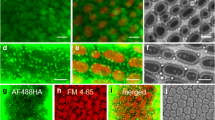Summary
Detergent-treated cell models ofEuglena gracilis showed rounded-up movement of the cell body upon addition of ATP and Ca2+. Reactivation of the cell models was inhibited when the cell models had been treated with solutions containing >150 mM NaCl or >300 mM KC1. When the supernatant of salt-extracted cell models was subjected to sodium dodecyl sulfate-polyacrylamide gel electrophoresis, two distinctive bands of 120 and 160 kDa were found to be enriched. The cell membrane and associated cytoskeleton (pellicular complex) were isolated after treatment with salt solutions, and examined by electron microscopy to identify essential cortical structures required for reactivating rounding-up cell movement. Among three regularly arranged microtubules, only one and its associated structures were selectively dissolved from the pellicular strips, while the other pellicular elements remained intact. These structures were located in the groove region where sliding between strips is believed to occur during cell shape change. These results suggest a possible involvement of microtubule 2 and its associated bridges in active sliding between adjacent pellicular strips during euglenoid movement.
Similar content being viewed by others
References
Bell CW, Fraser C, Sale WS, Tang WJY, Gibbons IR (1982) Preparation and purification of dynein. Methods Cell Biol 24: 373–397
Bovee EC (1982) Movement and locomotion ofEuglena. In: Buetow DE (ed) The biology ofEuglena, vol 3. Academic Press, New York, pp 157–161
Bracher R (1919) Observations onEuglena deses. Ann Bot 33: 93–108
Brady ST (1985) A novel brain ATPase with properties expected for the fast axonal transport motor. Nature 317: 73–75
Chang HW, Bock E (1977) Molecular forms of acetylcholine receptor: effects of calcium ions and a sulfhydryl reagent on the occurrence of oligomers. Biochemistry 16: 4513–4520
Diehn B (1979) The interactions of photic and chemical stimulus/response systems inEuglena gracilis. Acta Protozool 18: 7–16
Dubreuil RR, Bouck GB (1985) The membrane skeleton of a unicellular organism consists of bridged, articulating strips. J Cell Biol 101: 1884–1896
Lee G (1993) Non-motor microtubule-associated proteins. Curr Opin Cell Biol 5: 88–94
Mikolajczyk E, Kuznicki L (1981) Body contraction and ultrastracture ofEuglena. Acta Protozool 20: 1–24
Murray JM (1981) Control of cell shape by calcium in the Euglenophyceae. J Cell Sci 49: 99–117
Olmsted JB (1986) Microtubule-associated proteins. Annu Rev Cell Biol 5: 421–457
Reynolds ES (1963) The use of lead citrate at high pH as an electron-opaque stain in electron microscopy. J Cell Biol 17: 208–212
Scholey JM, Porter ME, Grissom PM, McIntosh JR (1984) Identification of kinesin in sea urchin eggs, and evidence for its localization in the mitotic spindle. Nature 318: 483–486
Spurr AR (1969) A low-viscosity epoxy resin embedding medium for electron microscopy. J Ultrastruct Res 26: 31–43
Suzaki T, Williamson RE (1983) Photoresponse of a colorless euglenoid flagellate,Astasia longa. Plant Sci Lett 39: 101–107
— — (1985) Euglenoid movement inEuglena fusca: evidence for sliding between pellicular strips. Protoplasma 124: 137–146
— — (1986a) Pellicular ultrastructure and euglenoid movement inEuglena ehrenbergii Klebs andEuglena oxyuris Schmarda. J Protozool 33: 165–171
— — (1986b) Ultrastructure and sliding of pellicular structures during euglenoid movement inAstasia longa Pringsheim (Sacomastigophora, Euglenida). J Protozool 33: 179–184
— — (1986c) Reactivation of euglenoid movement and flagellar beating in detergent-treated cells ofAstasia longa: different mechanisms of force generation are involved. J Cell Sci 80: 75–89
Wanger MC, Pfister KK, Bloom GS, Brady ST (1989) Copurification of kinesin polypeptides with microtubule-stimulated Mg-ATPase activity and kinetic analysis of enzymatic properties. Cell Motil Cytoskeleton 12: 195–215
Author information
Authors and Affiliations
Rights and permissions
About this article
Cite this article
Murata, K., Suzaki, T. High-salt solutions prevent reactivation of euglenoid movement in detergent-treated cell models ofEuglena gracilis . Protoplasma 203, 125–129 (1998). https://doi.org/10.1007/BF01279468
Received:
Accepted:
Issue Date:
DOI: https://doi.org/10.1007/BF01279468




